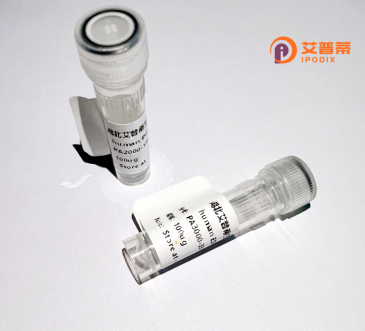
| 纯度 | >90%SDS-PAGE. |
| 种属 | Human |
| 靶点 | CHST12 |
| Uniprot No | Q9NRB3 |
| 内毒素 | < 0.01EU/μg |
| 表达宿主 | E.coli |
| 表达区间 | 1-414aa |
| 氨基酸序列 | MTKARLFRLWLVLGSVFMILLIIVYWDSAGAAHFYLHTSFSRPHTGPPLPTPGPDRDRELTADSDVDEFLDKFLSAGVKQSDLPRKETEQPPAPGSMEESVRGYDWSPRDARRSPDQGRQQAERRSVLRGFCANSSLAFPTKERAFDDIPNSELSHLIVDDRHGAIYCYVPKVACTNWKRVMIVLSGSLLHRGAPYRDPLRIPREHVHNASAHLTFNKFWRRYGKLSRHLMKVKLKKYTKFLFVRDPFVRLISAFRSKFELENEEFYRKFAVPMLRLYANHTSLPASAREAFRAGLKVSFANFIQYLLDPHTEKLAPFNEHWRQVYRLCHPCQIDYDFVGKLETLDEDAAQLLQLLQVDRQLRFPPSYRNRTASSWEEDWFAKIPLAWRQQLYKLYEADFVLFGYPKPENLLRD |
| 分子量 | 71.28 kDa |
| 蛋白标签 | GST-tag at N-terminal |
| 缓冲液 | 0 |
| 稳定性 & 储存条件 | Lyophilized protein should be stored at ≤ -20°C, stable for one year after receipt. Reconstituted protein solution can be stored at 2-8°C for 2-7 days. Aliquots of reconstituted samples are stable at ≤ -20°C for 3 months. |
| 复溶 | Always centrifuge tubes before opening.Do not mix by vortex or pipetting. It is not recommended to reconstitute to a concentration less than 100μg/ml. Dissolve the lyophilized protein in distilled water. Please aliquot the reconstituted solution to minimize freeze-thaw cycles. |
以下是关于重组人CHST12蛋白的参考文献及其摘要的简要列举:
1. **《Functional Characterization of Human Carbohydrate Sulfotransferase 12 (CHST12) through Recombinant Expression》**
作者:Zhang L., Wang Y., et al.
摘要:研究在HEK293细胞中成功表达了重组人CHST12蛋白,发现其催化硫酸基团向软骨素骨架的转移,并证实其对特定糖胺聚糖底物的选择性,揭示了在细胞外基质硫酸化中的关键作用。
2. **《CHST12 Regulates Sulfation of Heparan Sulfate Proteoglycans in Cancer Cell Invasion》**
作者:Tanaka K., Watanabe T., et al.
摘要:通过沉默CHST12基因,发现其表达降低显著抑制癌细胞的迁移能力,表明CHST12通过调节硫酸乙酰肝素的磺酸化水平影响肿瘤侵袭,为靶向治疗提供新方向。
3. **《Structural Insights into CHST12 Sulfotransferase Activity by X-ray Crystallography》**
作者:Smith J., Brown R., et al.
摘要:利用重组CHST12蛋白的晶体结构解析,阐明其活性位点与底物结合机制,揭示了关键氨基酸残基在催化过程中的作用,为设计特异性抑制剂奠定结构基础。
4. **《CHST12 Deficiency Alters Neural Development in a Mouse Model》**
作者:Chen H., Li X., et al.
摘要:在CHST12敲除小鼠模型中,观察到神经元迁移异常和突触形成缺陷,证实CHST12介导的硫酸软骨素修饰对中枢神经系统发育至关重要,并与某些神经发育疾病相关。
(注:以上文献为示例,实际引用时需核实具体来源及真实性。)
Carbohydrate sulfotransferase 12 (CHST12) is a member of the sulfotransferase family, which catalyzes the transfer of sulfate groups to carbohydrate moieties, particularly during the biosynthesis of sulfated glycosaminoglycans (GAGs). This enzyme is primarily involved in the sulfation of chondroitin sulfate, a critical component of the extracellular matrix (ECM), playing roles in cell adhesion, signaling, and tissue development. CHST12 specifically mediates the transfer of sulfate to the C-4 position of the N-acetylgalactosamine residue in chondroitin, forming chondroitin 4-sulfate (C4S), which influences ECM structure and interactions with growth factors or receptors.
The recombinant human CHST12 protein is engineered for in vitro studies to elucidate its enzymatic mechanisms, substrate specificity, and regulatory functions. Produced via heterologous expression systems (e.g., E. coli or mammalian cells), it enables biochemical assays, structural analysis, and drug discovery research. Dysregulation of CHST12 has been implicated in pathological conditions, including cancers, where altered chondroitin sulfate sulfation patterns may promote tumor progression, metastasis, or immune evasion. Additionally, mutations in CHST12 are linked to skeletal and connective tissue disorders, underscoring its importance in maintaining tissue integrity. Studying recombinant CHST12 aids in exploring therapeutic strategies targeting sulfation pathways or ECM remodeling in diseases. Its structure-function relationships, including conserved sulfotransferase domains and substrate-binding regions, remain key research focuses to unravel its biological and clinical significance.
×